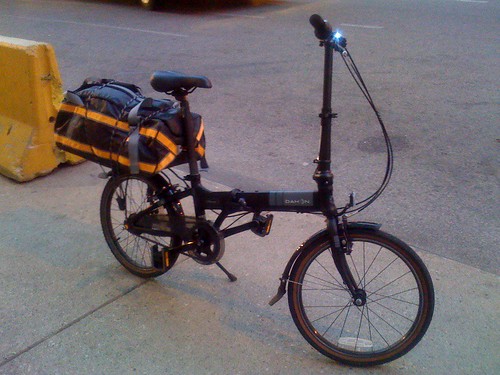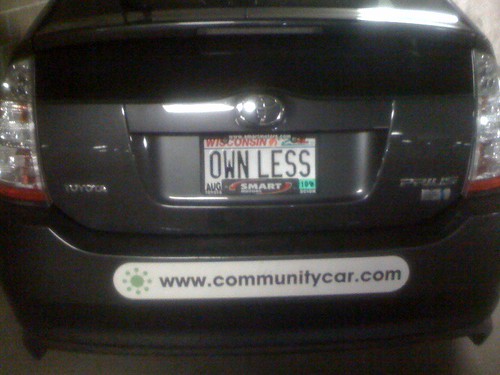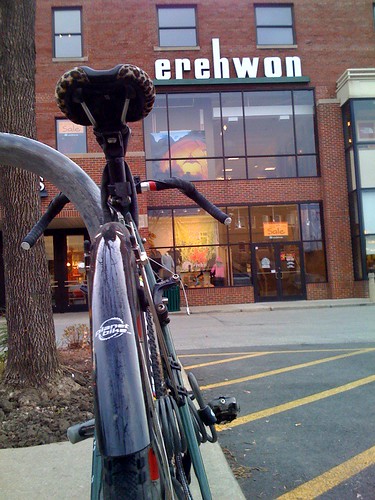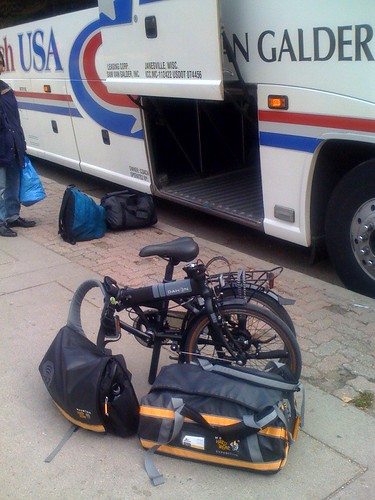But we're a business. If we're going to make a serious commitment to a car-free future it certainly cannot prove to be bad for business or we'll be out on the street. If we're going to convince anyone else to join us, we will have to demonstrate that this can be good for business! Here's a case study:
In early October 2009, Brad (our principle representative) was heading to Chicago to attend a national planning meeting for one of our vendors. Our main office in Madison, Wisconsin isn't too far away and there are a number of travel options: automobile is generally the default, but it isn't unusual for business travelers to fly, intercity bus service is very direct, I have made the trip by bicycle (not the most practical mode, granted!), and we're working on high-speed rail (maybe next time).
Brad decided to give the intercity bus a go. A typical Chicago trip would include visiting accounts across the region, but in this case he was traveling to sit in a conference room for a couple days - there wasn't going to be much need for a car once he arrived. Traveling by plane over such a short distance seemed a bit extravagant. Not to be outdone by my Chicago-Madison cycling adventure, Brad brought his folding bike along for the ride and used it to solve transit's "last mile conundrum," referring to the challenge of mobility between the start/finish of trips and mass-transit hubs. (Think the folding bike is dorky? It could be worse!)

The trip was a success, and aside from some gentle ribbing for arriving on this unusual looking contraption, the bike-bus-bike solution went off without a hitch. But how did it compare to the other options: car and plane? Let's examine the data:
Direct Expenses
The direct costs of travel is an obvious first measure, and the roundtrip expenses represented here make a compelling case for intercity bus travel:

Furthermore, there are a number of indirect costs not reflected in this chart. Parking at Chicago's Hampton Inn is $25 a day ($75 for the trip). Neither the bus nor the plane consider travel to and from the destination. A taxi from O'Hare Airport to Chicago's Loop is $40, one-way. The bus station was just 1.5 miles from the hotel, so the folding bike proved an economical and enjoyable solution!
Productivity
Productivity is an important metric to consider. Between wifi hotspots and 3G-enabled devices, the geography of “the office” is changing; with some discipline we are able to work effectively from almost anywhere now. A couple years ago, we'd have to look at this chart and conclude that driving is the best way to get to Chicago; flying and intercity bus just consume too much precious time. However, we can now break out the productive time from each transportation option, and the bus is looking even more attractive:

I've defined productive time as time on-line (3G on the bus) or with the laptop open (on the plane). Seasoned road-warriors may contest the lack of productive time in a car; granted mobile phones can help get some business done on the road, but in my experience these are low-value conversations, immediate follow-up is impossible, and it is increasingly illegal. Further, some time-management experts suggest uninterrupted blocks of time (focused work, such as on an intercity bus) can be far more productive than multitasking in the office.
(Note we could rework our expenses chart to include the lost opportunities from this 'wasted time.' The boss's time is valued at $100/hr - that's his opportunity cost, not salary. This would add about $200 to the cost of traveling by bus and $400 to the cost of plane and automobile travel. The intercity bus is looking even better.)
CO2 Emissions
Barack Obama has pledged to create a carbon market to incorporate some of the costs of climate change into the costs of doing business. Until then, putting a dollar value on this externality is almost impossible, but as a company we have decided that certain goals are worth pursuing. Our business and our passions are in the outdoors, and climate change is an existential threat to the health of ecosystems and of our business. Minimizing our CO2 footprint is a top priority. Air travel, especially short trips, are particularly deleterious. Studies have found intercity bus to be among the least-worst options, and our analysis of this case study supports this:

(For the record, we are leery of carbon-credit/carbon-trading schemes; purchasing carbon credits in the first-class lounge is akin to buying indulgences from the Catholic Church in 1500. It's better than nothing, but no substitute for meaningful lifestyle changes.)
So in conclusion, for this trip, intercity bus was the right decision - for the environment, for our values, and for our bottom line. Sometime that's not going to be the case, but we need to keep an open mind about taking the bus or train, and keep following the metrics to see when it makes economic sense to hop on the bike or bus. We're also going to keep the conversation going. As we speak, our colleague Bryan is riding from La Crosse, WI to Minneapolis, MN to attend Midwest Mountaineering's Winter Expo; visit him at the Expo or follow his journey on Twitter.
Click through here for a one-page summary of this case study, including the charts. Post it in the break room and start thinking outside the car.
Interested in going car-free? All-aboard!




